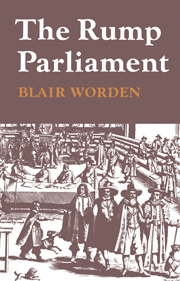Book contents
- Frontmatter
- Contents
- Dedication
- Acknowledgements
- Author's Note
- List of abbreviations
- Introduction
- PART ONE THE RUMP AND THE RUMPERS
- 1 Membership, attendance and allegiance
- 2 The limits of revolution
- 3 Moderation and conformity
- 4 Soldiers and clergymen
- 5 Commitment and corruption
- PART TWO THE RUMP AND REFORM
- PART THREE THE STRUGGLE FOR SURVIVAL, FEBRUARY 1649–SEPTEMBER 1651
- PART FOUR PARLIAMENT versus THE ARMY, SEPTEMBER 1651–APRIL 1653
- PART FIVE THE DISSOLUTION OF THE RUMP
- APPENDICES
- Bibliographical Guide
- Index
1 - Membership, attendance and allegiance
Published online by Cambridge University Press: 29 January 2010
- Frontmatter
- Contents
- Dedication
- Acknowledgements
- Author's Note
- List of abbreviations
- Introduction
- PART ONE THE RUMP AND THE RUMPERS
- 1 Membership, attendance and allegiance
- 2 The limits of revolution
- 3 Moderation and conformity
- 4 Soldiers and clergymen
- 5 Commitment and corruption
- PART TWO THE RUMP AND REFORM
- PART THREE THE STRUGGLE FOR SURVIVAL, FEBRUARY 1649–SEPTEMBER 1651
- PART FOUR PARLIAMENT versus THE ARMY, SEPTEMBER 1651–APRIL 1653
- PART FIVE THE DISSOLUTION OF THE RUMP
- APPENDICES
- Bibliographical Guide
- Index
Summary
Pride's Purge deprived the House of Commons of well over half its membership. Although only about 110 M.P.s seem to have been forcibly prevented by the army from entering the House, these were a minority of the members whose active participation in the Long Parliament came to an end in December 1648. Many withdrew at the purge of their own initiative, either out of distaste for the army's proceedings or because they suspected that attempted entry would be fruitless or dangerous. Others, whether because of disillusionment or old age, had long since ceased to take their seats with any regularity, and were merely confirmed in their abstinence by the purge. Of the 470 or so M.P.s qualified to sit at the beginning of December 1648, the purge permanently removed about 270. Temporarily it removed nearly 100 more, who stayed away from parliament in the weeks between the purge and the king's execution and who returned to join the Rump only in or after February 1649. It is impossible to determine exactly how many members sat in parliament during the Rump period, but the number is unlikely to have been significantly smaller or larger than 213. Of these numbers, nine - unlike their colleagues - were elected to parliament only after the purge, as a result of by-elections held on the deaths of certain of the excluded members. The nineteen members of the Rump who died between December 1648 and April 1653 were not similarly replaced.
- Type
- Chapter
- Information
- The Rump Parliament 1648–53 , pp. 23 - 32Publisher: Cambridge University PressPrint publication year: 1974



